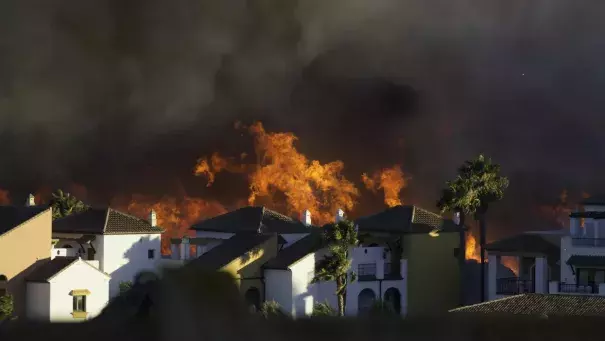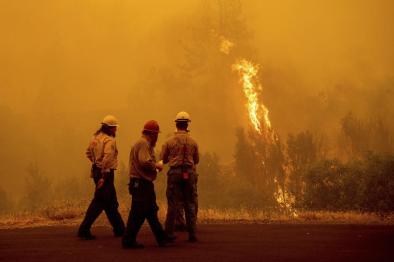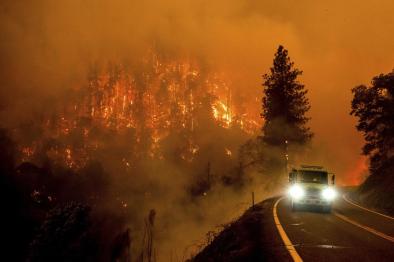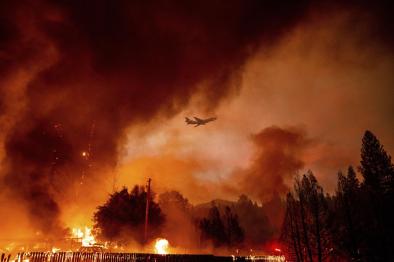Western Wildfire Season 2022
The American West has endured significant impacts from climate change in 2022, and as we enter the warmest months of the year, it’s expected to get worse. Record heat and drought, worsened by human-caused climate change, are increasing the threat of extreme fire behavior. New Mexico has already suffered through a year’s worth of fire activity - just through April, and globally, this year is the fifth warmest on record, so far.

Climate science at a glance
- Climate change makes it more likely that fires turn into catastrophic blazes through warmer temperatures, increasing the amount of fuel (dried vegetation) available, and reducing water availability through earlier snowmelt and higher evaporation.
- The frequency of hot, dry, and windy weather has increased in much of the US, meaning fires can quickly get out of control.[1]
- Climate change has doubled the area burned in the western US.[2]
- In California alone, there has been a fivefold increase in burned area extent in forests since 1972, mainly due to more than an eightfold increase in summer forest-fire extent due to warmer and drier conditions.
- The fire season has increased by more than two months in the western US, largely due to climate change.[3]
- California fires are burning at higher elevations than ever, creating new dangers.
- Climate change has doubled the frequency of autumn days with extreme fire weather conditions in California.[4]
- Costs in the U.S. associated with wildfire have grown from $1 billion per year between 1990-1999 to $13.6 billion by 2020.
- Damage associated with wildfires has grown substantially, with $81.7 billion, or 66% of all direct losses since 1980, occurring in the last five years.
What factors contribute to worsening wildfires in the western US?
Wildfire disasters are due to the combination of climate change, human land-use and forest management, which can make fires more severe, and the exposure to and vulnerability of populations to fires.[5] Wildfires are driven by three elements: topography (mountainous versus flat), vegetation (the fuel source), and weather. As topography and weather generally cannot be controlled, most fire prevention in wildlands focuses on removing dry vegetation and encouraging healthier ecosystems which won’t burn as easily. In some regions, forest mismanagement has increased wildfire risk.
Climate signal breakdown
Climate signal #1: Drought risk increase
The most direct link between climate change and fire is through how dry fuels get. What we've seen in the Western United States is that fuel dryness during the fire season explains around three quarters of the year-to-year variability in burned area extent. That has the effect of drawing moisture out of the fuels and priming the environment. Climate change plays a role through increasing the rate at which the temperatures warm, increasing the rate at which they draw moisture out of fuels. Drier conditions can allow fires to spread quickly.
Underlying year-to-year variability, research shows the Western United States in the midst of an extreme megadrought, among the worst in recorded history, and rising temperatures due to human-caused climate change are responsible for about half the pace and severity of the drought.[11]
Observations consistent with climate signal #1
- Sierra Snow Water Content is at 32 percent of the historical average for May 1. Snowpack is below average in the Southwest and surface moisture and groundwater are exceptionally low.
- The western U.S. had the driest December through February on record.
- Nearly one-half of the country — stretching from the Pacific Coast to the Great Plains and upper Midwest — was experiencing moderate to exceptional drought conditions in mid-March, and drought conditions were expected to continue and expand, according to NOAA’s U.S. Spring Outlook.
- The western U.S. is experiencing a megadrought, considered to be the worst one in 1,200 years. This extreme megadrought is showing no signs of ending anytime soon.
Climate signal #2: Land surface temperature increase
Humans spark most fires, but global warming makes it much riskier to have that spark light a fire by increasing the size, frequency, intensity and seasonality of western wildfires. Between 1901 and 2016, the average annual temperatures in the Southwest and Northwest increased by 1.6°F (0.9ºC), and nearly 2°F (1.1°C) respectively.
Hotter and drier conditions driven by global warming have doubled the area burned in the western US and increased the fire season in the region by more than two months.[2]
Observations consistent with climate signal #2:
- Temperatures in California have risen almost 3°F since the beginning of the 20th century. In the 126-year period of record (1895–2020), the six warmest years have all occurred since 2014 (2014, 2015, 2016, 2017, 2018, and 2020).
- In New Mexico, the average temperature in April – the month when nine fires over 1,000 acres started – was 4.0°F above average. From 1930 to 2006, the Southern Rocky Mountains saw an increase of two orders of magnitude in the numbers and burned areas of wildfires, with exceptionally large fires linked to hotter and dryer conditions in more recent years. The same study forecast that temperature increases over the period 2010–2070 would increase burned area in the Southern Rockies by two to five times.
- On May 16, New Mexico's Calf Canyon/Hermits Peak fire had burned 298,060 acres, becoming the largest fire in state history. The previous record was set by the Whitewater-Baldy fire, which burned 297,845 acres in southern New Mexico in 2012.
- The West has experienced a general and persistent increasing trend in temperatures for the last 40 years. Nine of the top ten warmest years have occurred since 2003 and 14 of the warmest 20 years have occurred since 2000.
Climate signal #3: Extreme heat and heat waves
Due to climate change, extreme heat and heatwaves are becoming more frequent, and this spells trouble for wildfire season in the western US. On a hot summer day, a small spark can ignite a raging wildfire, and data shows that many more wildfires burn in hotter years.[3]
Scientists have found a direct link between increasing heat extremes in the West and human-caused climate change.[7] As the West heats up, conditions are primed for wildfires to ignite and spread.[8] During the period 1980 to 2010, there was a fourfold increase in the number of large and long-duration forest fires in the American West, and the size of wildfires increased severalfold.[9][10]
Observations consistent with climate signal #3
- The western U.S. experienced a record heat waves in February and March.
- In early April, abnormally high temperatures sprawled over the western U.S. due to a dome of high pressure. Long-term warming from human-caused climate change increases the frequency and intensity of such events.
Climate signals #4 and #5: Snowpack decline and snowpack melting earlier and/or faster
Rapid, early snowmelt means a longer dry season, drier vegetation and larger fires in mid- and high-elevation forests. Warmer springs and summers, and the resulting shifts in snowmelt timing, have helped to drive marked increases in burned area in Western forests since the mid-1980s.[2]
Observations consistent with climate signals #4 and #5
- Spring snowpack is significantly below average in the Southwest and groundwater is exceptionally low across the West.
- April 1 snowpack in the Sierra Nevada dropped to one of its lowest levels in 70 years due to a record lack of precipitation in January, February and March.
- On May 1, California’s Department of Water Resources (DWR) announced that the May 1st Sierra snowpack measurement at Phillips Station was zero, saying, "The lack of frozen water reserve is alarming."








